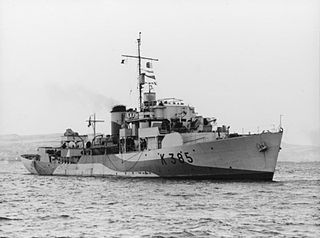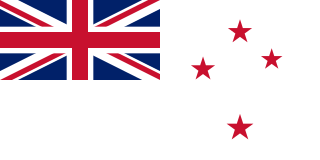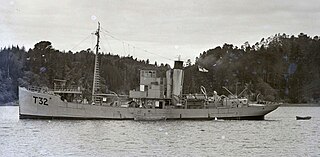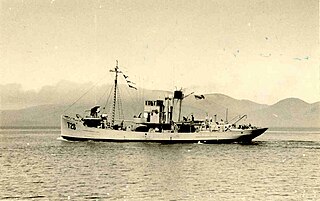
HMAS Echuca (J252/M252), named for the town of Echuca, Victoria, was one of 60 Bathurst-class corvettes constructed during World War II, and one of 36 initially manned and commissioned by the Royal Australian Navy (RAN).

The Royal New Zealand Navy is the maritime arm of the New Zealand Defence Force. The fleet currently consists of nine ships. The Navy had its origins in the Naval Defence Act 1913, and the subsequent acquisition of the cruiser HMS Philomel, which by 1921 had been moored in Auckland as a training ship. A slow buildup occurred during the interwar period, and then in December 1939 HMS Achilles fought alongside two other Royal Navy cruisers at the Battle of the River Plate against the German ship, Graf Spee.

HMNZS Wakakura (P3555) was a Moa-class inshore patrol vessel of the Royal New Zealand Navy. It was commissioned in March 1985 for the Naval Volunteer Reserve.

HMNZS Hawea (F422), formerly HMS Loch Eck (K422), was one of six Loch-class frigates that served in both the Royal Navy (RN) and the Royal New Zealand Navy (RNZN). The ship was laid down by Smiths Dock on 25 October 1943, launched on 25 April 1944 and commissioned into the Royal Navy as HMS Loch Eck on 7 November 1944.

HMNZS Arabis was a modified Flower-class corvette of the Royal New Zealand Navy (RNZN). Built for the British Royal Navy as HMS Arabis, she was transferred to the RNZN on completion. She was commissioned in 1944 and decommissioned in 1948.

Coastal Forces was a division of the Royal Navy established during World War II. It consisted of small coastal defence craft such as motor launches, submarine chasers, air-sea rescue launches, motor gun boats and motor torpedo boats. It did not include minesweepers, naval trawlers or landing craft. This article is about the equivalent boats used in the Royal New Zealand Navy (RNZN).
HMNZS Kiwi (T102) was a Bird class minesweeper of the Royal New Zealand Navy.

HMNZS Tui (T234) was a Bird-class minesweeper of the Royal New Zealand Navy. She was commissioned in 1941 for minesweeping and anti-submarine roles. Tui was the first of two ships with this name to serve in the Royal New Zealand Navy and was named after a native bird from New Zealand.
HMNZS Moa (T233) was a Bird-class minesweeper of the Royal New Zealand Navy (RNZN) that served during World War II.

Commissioned minesweepers and danlayers of the Royal New Zealand Navy (RNZN) from its formation on 1 October 1941 to the present. The RNZN was created two years into World War II. For coherence this article covers the war years from the start, and thus includes also the New Zealand minesweepers operating from the beginning of the war.

Vice Admiral Sir Peter Phipps, was a senior officer of the Royal New Zealand Navy (RNZN) from the 1940s to 1960s.

The Royal New Zealand Naval Volunteer Reserve (RNZNVR) is the volunteer reserve force of the Royal New Zealand Navy (RNZN).

HMNZS Breeze (T02) was a coastal cargo boat which was requisitioned by the Royal New Zealand Navy (RNZN) and converted into a minesweeper.
HMNZS Gale (T04) was a coastal cargo boat which was requisitioned by the Royal New Zealand Navy (RNZN) and converted into a minesweeper. She was the first New Zealand vessel to go into action against Japan.

HMNZS Puriri (T02) was a coastal cargo ship which was requisitioned by the Royal New Zealand Navy (RNZN) and converted into a minesweeper. She was sunk by a German naval mine 25 days after she was commissioned.

Commander Gordon Bridson, was a New Zealand swimmer who won two silver medals at the 1930 British Empire Games. He was also in the New Zealand Royal Naval Volunteer Reserve and in the Second World War, he served in the Royal New Zealand Navy. Seconded to the Royal Navy in 1940, he commanded a minesweeper vessel that accompanied coastal convoys along the English Channel. He was later the commander of the minesweeper HMNZS Kiwi which, with her sister ship Moa, sunk the Japanese submarine I-1 off Guadalcanal in the Solomon Islands.

HMNZS Waipu was one of eight steel New Zealand-built Castle-class ships built and commissioned by the Royal New Zealand Navy during World War II.

HMNZS Aroha was one of eight steel New Zealand-built Castle-class ships built and commissioned by the Royal New Zealand Navy during World War II. She was the first steel Castle-class trawler launched for the Royal New Zealand Navy.

HMNZS Waiho was one of eight steel New Zealand-built Castle-class ships built and commissioned by the Royal New Zealand Navy during World War II. She was the last Castle-class trawler built for any navy.

HMNZS Pahau was one of eight steel New Zealand-built Castle-class trawlers built and commissioned by the Royal New Zealand Navy during World War II.















